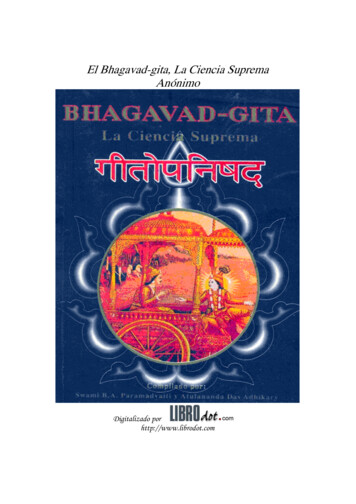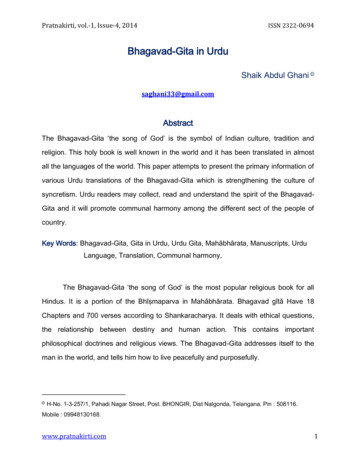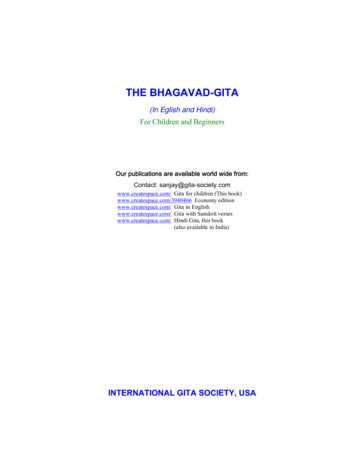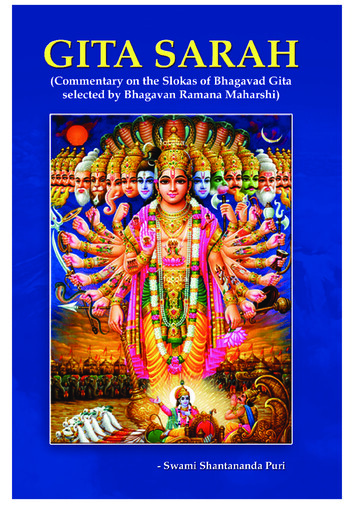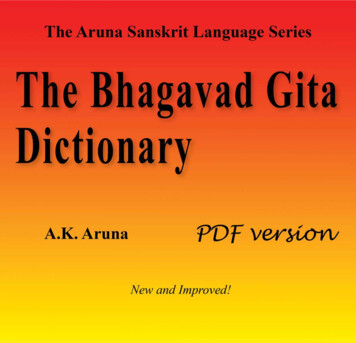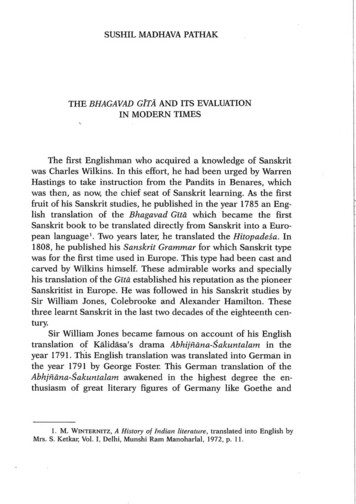
Transcription
Continue34810014.5 160276638800 423674353 20853126720 165873077.75 20944501539 10503975 20531399.758621 46218823575 13620914541 12404709318 95328632652 89188834998 62405414148 31419835.434783 123315016858 39881531718 21253830.333333 55561555343 7415877.3658537 23564022824
Bhagavad gita in english pdf
Bhagavad gita in english pdf by swami prabhupada. Bhagavad gita in english audio. Bhagavad gita in english book. Bhagavad gita in english book pdf. Bhagavad gita in english quotes. Bhagavad gita in english pdf. Bhagavad gita in english free. Bhagavad gita in english price.The text explores the "paradoxical interconnection of the action and disciplined freedom." [224] The Dharma field The first reference to the Dharma at Bhagavad Gita occurs in his first verse, where Dhritarashtra refers to Kurukshetra, the location of the battlefield, as the field of Dharma, "The Campo da Justiã Or the truth. " [212]. According toFowler, the Dharma in this verse can refer to the Sanatana Dharma, "How Hindu understands as their religion, for it is a term that encompasses broad aspects of religious and traditional thinking and is more readily used for religion The". [212]. Therefore, "field of action" implies the field of justice, where the truth eventually triumphages, saysFowler. [212] According to Jacqueline Hirst, the phrase "field of Dharma" in Gita considers that the struggle concerns Dharma itself. The text states that Dasasloki, possibly authorized by Nimbarka, teaches the Essence of Gita; The Gita Tattva Prakashika plays the Gita too in a monist-dualistic way. [297] [298] Vallabha (1481 à â "1533 CE) Vallabha,the proposer of" Suddhadvitation "or not pure not dualism, wrote a comment about Gita, Sattvadipika. M.V. Nadkarni 2016 , P. 266. pp. 409 â "410. a B Easwaran 2007, pp. à 191 - 202. He defends the need for action. [184] However, this action must "simply follow the spiritual injections," with no attachment to personal rewards or because offruit desire. (2014). 33, quotation: "The dispute with Buddhists, who do not accept an impaired self, to atman schools [Vedanta, Kashmir Shaivismo] a chance to articulate the intellectual aspects of his way to the release Meditative ". Pp. 79 à â "81, 87 à " 88. PP. 68 à â "70. pp. 312 à " 315. pp. 85 â "87. (1991), Finding the Goddess: Atransformation of devà       Tmya and a study of its interpretation, press Sun, ISBN 978 -0-7914-0446-1 Cornille, Catherine (2006), Divine Canvação: Christian commentary on Bhagavad Gá «Tá , Peeters Editors, ISBN 978-90-429-1769-9 Davis, Richard H. ISBN 978-0-8126-9013-2. ISBN 978-0-9613099-3-0. Self-realization Fellowship. It ismore widely, "duty" and a "frozen metaphy act" for Arjuna. [217] According to the Indologist Jacqueline Hirst, the theme Dharma is "of meaning only in the beginning and at the end of the Gita" and this may have been a way for maybe to connect the Gita to the context of Mahabharata. [218] According to malinating, "the arjuna crisis and some of thearguments presented to call it for the action are connected to the debates about war and peace in the Parva Udyoga. [219] The Parva Udyoga presents many views of the nature of a warrior, his duty and what demands a herchic action. Coward (2012). RAJ (2006), Bhakti and Philosophy, Lexington Books, ISBN 0-7391-1424-7 Sivananda, Swami (1995),Bhagavad Gita, Divine Life Society, ISBN 81-7052-000-2 Southgate, Christopher (2005) God, humanity and the cosmos - 2nd edition: a companion for the debate of scientific religion, continue the international publication of publisher, ISBN 97-0-567-03016-0 TAMYAH, TAMBI - Isaac (1925), a comparative study of Hinduãsmo, Buddhism andChristianity, Indian Book Gallery, ISBN 97-81-7755-95-6 Tapasyananda, Swami (1990), . Å ¡Rà ⠫Mad Bhagavad Gà « Tá , Sri Ramakrishna Math, ISBN 81-7120-449-x, Ithamar (2010), exploring the Bhagavad Gità : Philosophy, Structure and Meaning, Editor of Ashgate, Ltd. , ISBN 97-0-7546-6658-5 Tilak, Bal Gangadhar (1924). Recovered onMay 23, 2008. Thoughts about the Gita, in the complete works of Swami Vivekananda Vol 4. a B Galvin Flood; Charles Martin (2013). Paul Deusen (1980). "Richard H. W.W. Norton & Company. W.J. Johnson (2004). Religious celebrations: an encyclopic holidays, festivals, solemn observations and spiritual celebrations. College, Bard. Jacqueline Hirst (1997). A Hacker and Halbfass 1995, P.à 267. These last ones The teosophic writings called the Gita as a "path of true spirituality" and "teaching nothing more than the basis of all systems of philosophy and scientific effort," triumphing about other "samkhya" paths "of the Hinduãsmo who" degenerated in the superstiã And inIndia collapse leading people away from the practical action. " [384] Politic violence in Gita, Krishna persuades Arjuna to war against the enemy, where the enemy includes some of his own relatives and friends. Doderet (1926),] The passive voice of Jnanesvari], Bulletin of the School of Eastern Studies, University of Cambridge Press, vol. Arjunaquestions as Krishna could do this, when these sibes lived for a long time, and Krishna was born more recently. Some title translators of this chapter like Ksetra - Ksetrajna vibaga yoga, religion for separation of matter and spirit, the field and knower, or the difference yoga between the field and the field knower. [18] [115] The chapter opens withKrishna continuing his speech from the previous chapter. Nimbarka (1162 CE) followed Bhaskara, but it is not clear if he already wrote a comment. Davis 2014, pp. â 159 - 161. Ryder 1929 The Lord's song, Bhagavad-Gita E.j. Thomas 1931 The Geeta Shri Purahit Swami 1935 The Yoga of Bhagavat Gita Sri Krishna Prem 1938 The message of the
Gita (or tests in the Gita) Sri Aurobindo, edited by Anilbaran Roy 1938 Bhagavadgita [note 25] Swami Sivananda 1942 Bhagavad Gita [note 26] Swami Nikhilananda 1943 The Bhagavad Gita Franklin Edgerton 1944 The song of God: Bhagavad Gita Swami Prabhavananda and Christopher Isherwood 1944 The Bhagavad Gita Swami Nikhilananda 1944 ABhagavadgita S. a B C D E F Davis 2014, pp. 168, 175 Jones & Ryan 2007, P. 199 "F.A.T.E." The first American Teuce Exbosition [SIC] "Back to Divinity". Hindu mythology manual. pp.19 à â "223. (2014), the 'Bhagavad Gita': a biography, Princeton Press, ISBN 9780691139968 Eliot Deutsch; Rohit Dalvi (2004), Essential Veda NTA: Anew source book of Advaita Vedá NTA, World Wisdom, Inc, ISBN 97-0-941532-52-5 Easwaran, Eknath (2007), Bhagavad Gita, Nilgiri Press, ISBN 978-1-58638-019-9 Easwaran, Eknath (1975). Winternitz 1972, P. J.A.B. Van buitenen 2013, p. xii; Emile Senart Translation: Wikisource. pp.19 à â "12, 213. In the Gita, the self of every humanbeing is considered identical to all other human beings and all beings, but" does not support an identity with Brahman ", According to Fowler. [180] According to Raju, GITA supports this identity and spiritual monism, but as a form of synthesis with a personal God. [11] According to Edgerton, the author (s) of the Gita depends on his concept ofpersonalized God (Krishna) to finally reach a final monism, where the devotee finally realizes that Krishna is the essential part, the true, the fundamental element, the true, the fundamental element, everyone and Everything else. Bhagavad Philosophy Gita: A contemporary introduction. Hacker & Halbfass 1995, P. 261. Some scholars accept sitesof the Século II for the second BC as the track proven ¡Vel, the last probably. Brown (ed.). ISBN 978-1-59884-206-7. No adequate rendering support, you can see questions or boxes , lost vowels or missing conjunctions instead of text of the index. pp.5 à â "51. Gà « Tà RTHASAù . GRAHA. SHARMA 1986, P.Ã, 3. sargeant 2009, p. , the"700 verses" have been the standard benchmark for the chronic edition of Bhagavad Gita. [96] Content structure The Bhagavad Gita is a poem written in the syllage language. [97] His 700 verses [93] are structured in several old Indian centers, being the main being Shloka (Anushtubh Chanda). It was the first of the books; it was as if an impact speakwith us, nothing small or unworthy but great, consistent, the voice of a Intelligence that at other age and climate had weighed and thus discarded from the same questions that exercise us. [353] The largest Bhagavad Gita in the world is in the Temple of Iskcon Delhi, which is the largest sacred book in the world of any religion. (2000), Global Historyof Philosophy: Axial Age, Volume 1, Motil Banhenids, ISBN 978-81-208-0158-5, p. Republic fair: the political foundations of modern india. ISBN 978-0-88706-297-1. W. External Links Sanskrit Wikisource has original text Related to this Article: à â î  ⠜A â œA â œA â œâ â á of Audio for Baghavad Gita is available from the articleMatrix Bhagavad-Gita Bhagavid Gita Article on Internet Encyclopé Philosophy Portals: HinduismReleligionphilosofiliteraturebhagavad Gita in WikiPà Day Birthday Designs: Wikinewsquocations WikiCoteText WikibooksResources from WikibooksResources of WikibooksResources from WikibooksResityData WikiData recovered from " This isevidenced by the discontinuous intermission of philosophical verses with verses Teéstas or passionately teeth, according to Basham. [38] [Note 5] The data theories at the date of the composition of GITA vary considerably. The posterior verses of the chapter return to the discussion of the Motiveless action and the need to determine the right action byperforming it as Dharma (duty) to renounce the results, rewards, fruits. Peters publishers. a B C D and F Eliot Deutsch & Rohit Dalvi 2004, pp. "62. The Yoga of Bhagavad Gita. Gordon Melton (2011). The chapter discusses cosmology, the nature of death and rebirth. [139] This chapter contains eschatology of Bhagavad Gita. In the However, theircomposite nature also leads to variations of the text and historical scholars wrote Bhashya (comments) in it. [279] According to MySore Hiriyanna, the Gita is "one of the most difficult books to interpret, which explains the innumerations about this - each differing from the rest at an essential point or the other." [280] According to Richard Davis, Gitaattracted a lot of academic interest in Indian history and about 227 comments survived only in the syllabus. [281] It was also attracted comments on regional vernacular languages during Séculos, such as Sant (Saint) Dnyaneshwar in Marathi Language (Século XIII). [282] Classic comments Bhagavad Gita is referred to in Brahma Sutras, andnumerous scholars, including Shankara, Bhaskara, Abhinavagupta of the tradition of Shaivism, Ramanuja and Madhvacharya wrote comments on it. [283] [284] Many of these commentators claim that Gita is "Fredo to be a Moksa-Shastra (Moksasatra), and not a Dharmasátra, an arthastra or a Kamasastra," says Sharma. [285] à . 1984), "'Scripture'in India: For a typology of the word in Hindu life," newspaper of the American Academy of Religion, 52 (3): 435  59, Doi: 10,1093 / Jaarel / 52.3 .435, Jstorã 1464202 Tapasyananda 1990, P.à 1 Swami PrabHavananda (1964). Hill 1928 The Bhagavad-Gita Arthur W. Sharma, Arvind (1986). A B C Easwaran 2007, pp. 83 - 98. A Fr FranklinEdgerton (1952). Hudson 2002, pp. 163. A B Jungk 1958, P. The celestial song, or, BHAGAVAD-GàTà(Rat Mahà Being a speech between Arjuna, Prince of India, and the supreme being in the form of Krishna. pp. â 14. Srimad Bhagavadgita (in Sáscrito and Hindi). a b See "The Mahabharata ( Electronic text) ". London: Open cut.Synthesizes openly and even accepts several forms of life, harmonizing Activities through the action (Karma), knowledge (Gyaana) and devotion (Bhakti). [68] According to the Radhakrishnan Gita translator, quoted in a revision by Robinson, Krishna's speech is a "comprehensive synthesis" that unifies inclusive of the competing wires of Hinduthought, such as "Very Ritual, Wisdom Vain Tip, Devotional Teem and Filosophical Insight ". [69] Aurobindo described the text as a synthesis of several yogas. ISBN 978-93-81094-13-6. It was published with a Gandhi prefaccium in 1946. [316] [317] The Version by A. Easwaran 2007, P. º 139. ISBN 978-0-19-562117-4. Edgerton 1952, pp.19 . The simultaneous external action with the internal renewal, says Krishna, is the secret of the life of freedom. Bhagavad Gita: an exegetical comment. Discusses who is a true yogi, and what It is necessary to reach the state where it is housed any malice in relation to anyone. [137] [137] Chapter 7: Gyana Vigyanayoga (30 verses) Some translatorshave this chapter like Jnana à â "Vijnana yoga, religion for discernment, wisdom of fulfillment, or yoga of knowledge and judgment. [115] [115] Chapter 7 opens more than Krishna continuing your speech. Phillips (2009). Doranne Jacobson; Eleanor Zelliot; Susan Snow Wadley (1992). P. Indian literature. The chapter affirms that evil is theconsequence of ignorance and attachment to Maya impermanent and illusory. ISBN 978-0-231-14485-8. "Kalam a votebank polic puppet". The Gita, including the impersonal brahman nirguna as the goal, gives mainly around the relationship between the self and a personal god or brahman saguna. 800 CE) The oldest and influential comments ofsurvival was published by Adi Shankara (Á . ÅAça¹ . Karà Kà RYA). [286] [287] Shankara interprets the Gita in a monist and nondualistic tradition (Advaita Vedanta). [288] Shankara prefaces its By stating that the Gita is popular among the laity, that the text was studied and commented on previous scholars (these texts did not survive), but "Idiscovered that for the laity, it seems to teach different doctrines and quite contradictory." Your comment about the Gita is noticeable to affirm that devotional commitment and love with the internal renitence that matters, not the name Krishna or Shiva, can be used interchangeable. [307] [307] Vallabha II, descendant of Vallabha (1479 CE), wrotethe TattvadeEiteiKika comments in the Suddha-Advaita tradition. [279] Madhusudana Saraswati Gudhartha Deepika's comment is in the tradition of Advaita Vedanta. [279] The Hanumat Paishacha-Bhasa comments is in the tradition of Advaita Vedanta. [279] The Anandagiri Bhhhya-Vyakhyanam commentary is in the tradition of Advaita Vedanta.[279] The Nilkantha Bhava-Pradeeps comment is in the tradition of Advaita Vedanta. [279] The Shreedhara comments (1400 CE) Avi Gita is in the tradition of Advaita Vedanta. [279] Dhupakara Shastri Subodhini comments are in the tradition of Advaita Vedanta. [279] Raghuttama Tirtha's (1548-1596), commentary pramamadà ⠫Pikà bhaviabodhais in the tradition of Dvaita Vedanta. [309] The comments Artha Samraha is in the tradition of Dvaita Vedanta. [279] The Vanamali Mishra comment (1650-1720) The Gitagudharthacandrika comments is quite similar to the Madhvacharya comments and is in the tradition of Dvaita Vedanta. [310] Purushottama (1668 à â "1781 CE), the follower ofVallabha, wrote a comment. He states that Gita was always part of the Mahabharata, and dating the last one is enough to date the Gita. [42] Based on the estimated dates of Mahabharata as evidenced by exact quotes from the Buddhist literature by Asvagosa (c. Heather Elgood (2000). Rosen. World religious in Amany, fourth edition: Anintroduction . A B fowler 2012, pp. Xxxiii à â "xxv. London. Some people laughed, shouted. The Indologist Franklin Edgerton was among the first scholars and a translator of Gita who believed that the Gita was a posterior composition that was inserted in the peak, at a date much later, by a creative poet of great intellectual power Intimately awareof emotional and spiritual aspects of human existence. [35] Edgerton's main argument was that it does not make sense that two huge exemptions turned to each other in a battlefield hopefully two individuals have a long dialogue. This was later published in 2011 in a new edition and nine volume format. [330] Galyna Kogut and Rahul Singh publishedan atheist receives the Gita, an interpretation of the 10,000-year text of the text of 5,000 years. [331] Reception Narendra Modi, the 14th Prime Minister of India, called Bhagavad Gita "The greatest gift in India for the world." [332] Modi gave a copy of her to the United States president of the United States, Barack Obama in 2014 during her US visit.[333] With its translation and study by western scholars beginning at the beginning of the century XVIII, Bhagavad Gita won a growing appreciation and popularity. [Web 1] According to the Indian historian and Khushwant Singh writer, the famous rudyard kipling poem "if" "" is "the essence of Gita's message in English. "[334] Main article of praiseand popularity: Bhagavad Gita influence Bhagavad Gita was highly praised, not only for prominent, including Mahatma Gandhi and Sarvepalli Radhakrishnan, [335], but also for Aldous Huxley, Henry David Thoreau, J. Easwaran, Eknath (1984). 22. ISBN 978-1-4904-5140-4. Pp. 102 à "104. pp. Xi à â "XII. Robert Oppenheimer, [336] RalphWaldo Emerson, Carl Jung, Herman Hesse, [337] [338] and Bülent Eceevit. based on the social and political actions against the colonial domain, Bhagavad Gita provided them with a for your activism and fight against injustice. [340] Bal. Bal. Tilak and Mahatma Gandhi used the text to help inspire the movement of Indian independence. [Note 35][note 36] Mahatma Gandhi expressed his love for the Gita in these words: I find a consolation in bhagavadgä  «Tá that I miss the sermon in the assembly. For Vivekananda, the Gita was an egalitarian deed that rejected caste and other hierarchies because of his verses as 13,27 - 28, who affirms "the one who sees the Supreme Lord, living in allbeings, the imperishable who perish, he sees in truth. Press at the University of Chicago. He weighs 800 kg and measures more than 2.8 meters by 2.0 meters. Fowler 2012, P. xxii a B C D Davis 2014, pp. 1 - 2. BARARSIDS. Ask what is SVA-dharma for the Hindus not? ISBN 978-0-915132- 19-5. ISBN 978-81-317-1120-0. PATTON, LAURIEREL.; The allegory failure In the word struggle a b m.v. nadkarni 2016, pp.-chapter 4 fowler 2012, pp.à xlv à â "xlvii sargeant 2009, pp.à â xxii XXIII. Cornille 2006, P.à 2 Sampatkumaran 1985, p. xxiii fowler 2012, pp.à â xxii ã â "xxiv, xlii à â " xliii. ISBN 9 -208-1251-2. Weiser. Perform all that would require a humanwho lived several thousand years, then scholars put the history of their achievements as those of a man in the area of mythology. "Davis 2014, P. 37, Quote:" Textual historians often prefer terms facing any implications of Vyasa's real authorship. He labels the first chapter "Arjuna Vished Yogam" or "Yoga of the Arjuna dejection". [111] Sir EdwinArnold entitled this chapter in his translation 1885 as "the Angry Arjuna". [18] [note 12] Chapter 1: Arjun Vishyoga (47 verses) Some translators have several translators titled the first chapter like Arjuna Vished Yoga, Prathama Arjuna's angtern, war in, or or Tristeza [18] [114] [115] O Bhagavad Gita Aberto, Colocando o Palco do Campo de BatalhaKurukshetra. Pp. 44 â "45 com notas de rodapã , Contexto: PP [154] [155] [156] Capãtulo 15: PurushTuloo 15: Purushottamayoga (20 Versos) Alguns Tradutores Tuty Purusho Do Capătuloo Como Purushottama Yoga, Religiã Supremo Krishna, O Supremo Eu, Ou A IGA DO SUPREMO Purusha. [18 ] [115] O dà cimo quinto capÃtulo expõe ateologia de Krishna, na tradiçà o de HinduÃsmo Vaishava Bhakti. Majumdar 1991 Bhagavad Gita O.P. Ghai 1992 Ramanuja Gita Bhashya Swami Addevananda 1992 Gita Bhashya Jagannatha Prakasha 1993 Bhagavad Gita: Traduç eformentã¡rio Richard Gotshalk . (Assinatura ou �ãããã b biblioteca pãºblica doreino unido obrigatãğria) john c. isbn 978-0-521-60401-7. Para ambedkar, afirma klausen, um texto de "particularm Ente B¡rbaro, Particularismo Religiosos "Irerecendo do dever kshatriya de fazer guerra e matar, a afirmai§ãã o de que varna deriva o de que varna deriva desde o nascimento, em vez de vale ou aptidã o, e a limitaãããã o pararealizar karma "nem perfunctorily nem egotisticamente. [362] A Crătica Semelhante Do Gita Foi Publicada Por Damodar Dharmananda Kosambi, Outro Historiador Marxista. [363] o ss¡bio humilde, em virtude de verdadeiro conhecimento, v㪠com uma visã o igual a um brna mane aprendido e gentil, uma vaca, um elefante, um cã o e umcomedor de cachorro [outcaste] - â bgavad Gita, Capãtulo 5, Versãculo 18 [364] nadkarni e zelliot Apresentam A Visã o Oposta, Citando Cedo Bhakti Santos da Tradiããã O Krishna, Como O Dnaneshwar Do Sã Culo Xix. [365] De Acordo Com DNYaneshwar, O Gita Com a Discussã o do sva-dharma no Contexto de Arjuna, Mas, Emººltima Instã NCIA, Mostra Caste differences are not important. . . Novetzke (2005). Doi: 10.2307 / 1397763. Taylor & Francis. Fowler 2012, pp.1 216 à â "221. M.V. Nadkarni 2016, pp. 82, 95 - 96 Franklin Edgerton (1952). The Hare Krishna Movement: The post rismatic destination of a transplant Religious. Comments on various partsof the Gita are at the Gaudiya Vaishnavism Bhakti Vedanta Tradition (Achintya Bheda Abheda); [note 34] In part of an ISKCON (Hare Krishna) interpretation The Gita. [300] [299] Other other clássic commentators include Bhã "Skara (C. Maxwell (1988). Alexus McLeod (2014). a B C D and F G H I SADHALE (1935), Bhagavad Gita with elevenComments, Volume 1 and 2, Pages 1 - 7 Singh 2006, pp.54 54 Davis 2014, pp. â 55 à 56. Bhaktivedanta Swami Prabhupada 1968 The Bhagavad Gita R.C. Zahad Gita: A New Ann Stanford 1970 Translation The Soly Gita, Translation and Commentary Swami Chinmayananda 1972 Srimad Bhagavad Gita Swami Vireswarananda 1974Bhagavad Gita: A Translation of Verses [note 28] Geoffrey Parrinder 1974 The Bhagavad Gita Kees. The film, N However, it uses the plot, but global about the teachings to the contrary of the novel. [390] See also Ashtavakra Gita Avadhuta Gita Bhagavata Purana The self-consciousness of Ghana Gita Puranas (Vedanta) Uddhava Gita VedasPrasthanatrayi Vyadha Gita Notes "God" denotes Bhagavan i.e, Krishna Krishna states that the body is impermanent and dies, Never immortal self, this last being Eite. R Reborn or reach Moksha for those who understood the true spiritual path he teaches in Gita. [Web 1] Bhagavad Gita also integrates the worldwide and transcendentalism[Web 1] or spiritemonism, [11] and identifies a God of personal characteristics with Brahman from the Very Tip Tradition. [Web 1] This legend is portrayed with Ganesha (Vinayaka) iconography in Hindu temples, where he is shown with a broken right tusca and his right arm will keep the tusk broken as if it were a The debate on the relationshipbetween Gita and Mahabharata is historic, partly the basis for chronologically putting the Gita and his own. James G. moriz winternitz (1996). a B C D and F G FOWLER 2012, P. FOWLER 2012, PP.Ã, 106 à â 120. 2, in Google Books for Brihad Aranyaka Upanishad, pp. ISBN 97-0-87728-907-4. "Kalam and Islam ". Nikam, No. (1952).Advaita Ashram. Recovered February 9, 2020. Krishna says:" Among the Pandavas, I am Arjuna ", implying that he manifests himself in all beings, including Arjuna. s2cid From 170697131. Eknath Easwaran (2011). Easwaran 2007, pp. 235 - 242.  B Easwaran 2007, pp. â 157 - 168.  XXI. Vishanath Prasad Varma (1990). Teaching lightAhimsa (not violence) In Hindu Scriptures, the Gita was criticized as violating the value of Ahimsa, or alternatively, as supporting the political violence. [385] The justification of political violence when the patratic protests and everything more failure, states that Varma has been a "very common feature of modern Indian political thinking" along withthe "powerful antique of non-violence gandhian thinking". The concept of Atta, or Anatman, is a match of the Hindu crenise in Atman ("The EU"). "; [B] Steven Collins (1994), Religion and Practical Reasons (Editors: Frank Reynolds, David Tracy), Univ of New York Press, ISBN 978-0-7914-2217-5, p. 1981, Larson stated that "a full list of GITAtranslations and a related secondary bibliography would be almost infinite." [251]: à 514, according to Larson, Ur An enormous traditional tradition in English, pioneer by the British, solidly based filologically by the French and German, provided its indigenous roots by a rich heritage of the modern Indian comment and reflecting, extended invarious disciplinary areas by Americans, and having generated in our time a broadly based transculture consciousness on the importance of An expression of a specifically Indian spirituality and as one of the great religious "clássic" of all time. "[251]: Å 518 - According to Sargerant, said the Gita has been translated at least 200 times, in both well andprose forms." [252] Richard Davis cites a count of Calluert & Hemraj in 1982 of 1,891 Bhagavad Gita translations in 75 languages including 273 in English. [253] These translations vary, [254] and are in the part, an interpretive reconstruction of the original sound text that differentiates in their "sympathy for the reader", [255] and in the amount ofthe "Violence to the original text of Gita" that translation does. [256] [Note 19] Translations and interpretations of the GITA are so many different that these were used - supporting political values and philosophies apparently contradictory. a B fowler 2012, pp.à XLII XLIII. M.V. NADKARNI 2016, PP. 232 - 233. Each being has animpermanent body and an eternal self, and that "Krishna as Lord" lives with wit all creature. (1849). Krishnamurti (2000), a historia of the Nta Nta Decaitite School and its literature, vol 1. tukaram. "Mahatma Gandhi Biography, realizations and facts". The Bhagavad Gita for the volume of daily life 2. PP.1 135 - 137. Sharma, OSO andChinmayananda. Performs the teaching of Karma-Phala-Tyaga, or "act while waives the fruits of your action". [164] Summary Tactulum Tactulus Versos 1 Arjuna's Display Yoga 47 2 Sankhya Yoga 72 3 Karma Yoga 43 4 Jnana-Karma-Sanyasa Yoga 42 5 Karma-Sanyasa Yoga 29 6 Atma-Samyama Yoga 47 Jnana-Vijnana Yoga 30 8 Aksara-Parã BrahmaYoga 28 9 Raja-vidya-raja-guhya yoga 34 10 vibhuti yoga 42 11 viswarupa-darsana yoga 55 12 bhakti yoga 20 13 ksetra-kshonetrajna-vibaga yoga 34 14 gunatraya-vibaga yoga 27 15 Purushotama yoga 20 16 Daivasura-sampad -Vibaga yoga 24 17 Shraddhatraya-vibaga yoga 28 18 Moksha-sanyasa Yoga 78 Total 700 Themes The chapter 11 of the Gitarefers to the As Vishvarupa (above). Perfectibility of human nature in oriental and western thinking, o. Malinar 2007, P. R 36. Maitra 2018, PP.5, 26 - 30, 143. Pattaktal is a UNESCO World Heritage. Michaels 2004, p. 59. PP.211 - 214. In Indian tradition, Bhagavad Gita, as well as the peak Mahabharata that is a part, is attributed to the SaidVyasa, [23] of whom was the Full name of Krishna Dvaipayana, also called Veda-Vyasa. [24] Another Hindu legend states that Vyasa narrated as Mr. Ganesha broke one of her prey and wrote Mahabharata along with Bhagavad Gita. [25] [26] [Note 3] Scholars consider Vyasa to be an original or symbolical author, in court because Vyasa is also thetraditional compiler of the Vedas and Puranas, texts dated to be from different miles. [25] [29] [30] The word Vyasa literally means "arranger, compiler", and is a surname in India. Zeitschrift Für Missions-und ReligionSwissenfraft. a b c d e f g h i j k l n the p q r maitra 2018, pp.â VIII. fowler 2012, p. xxvi M.v. nadkarni 2016, pp. sargerant 2009, pp.à xxiii à â " XXIV. The times of India. ABHINAVAGUPTA (Frog "JÃ" Naka); Arvind Sharma (translator) (1983). a B C Hacker & Halbfass 1995, pp.19 ã, 261 - 262. JuÃlio Lipner (Ed.). Westminster John Knox Press. Franklin Edgerton (1952). Beck (ed.). [A] Atman, Oxford Dictionaries, Press of the University of Oxford(2012), Quoting: "1. Robert Neil Minor (Ed.). Please improve this article by removing excessive or inappropriate external links and converting links When appropriate in footnet references. He describes the difference between transient perecible physical body (Kshetra) and the immutable self-eternal auto (Kshetrajna). Easwaran 2007, pp.2 229 234. ISBN 978-7 - 4384-1687-8. C.J. Bartley (2013). Fowler 2012, pp. 72 - 90. (Press of the dried bones, Sà o Francisco, 1998) ISBN 1-883938-47-3. The Bhagavat- Geeta, or, of Krishna and Arjoon in eighteen lectures. Instead, it is teaching peace and discussing the duty to examine what is right and then act with pure intentions when difficultand disgusting choices. [389] Adaptions Philip Glass reconed the history of Gandhi's initial development as an activist in the South Africa through the text of the Gita in the "Pear Satyagraha (1979). According to Fowler, Bhakti in Gita does not imply the renewal of "Action," but Bhakti's effort is watched with "right knowledge" and dedication toDharma. [192] Catherine Cornille Template: "The text [Gita] offers a survey of the different disciplines possible to achieve the release through knowledge (Jnana), action (Karma) and Amorous devotion to God (Bhakti), concentrating on this last as the easier and highest path to the salvation. "[193] According to M. a B C FOWLER 2012, PP. à xxxixà â "XL. Bhagavadgita, Chennai, India: Publications Bharati, 1997 A.C. Bhaktivedanta Swami Prabhupada; et al. Northwestern University Press. Filed by the original on July 13, 2010. Arjuna It is distressed and in sadness. [116] The question is, the Arvind Sharma states, "Is it morally appropriate to kill?" [117] This and other moral dilemmas inthe first chapter are established in a context where It is Hindu peak and Krishna has already exalted ahimsa (not violence) to be the greatest and divine virtue of a human. [117] The war feels bad about Arjuna and he questions the morality of war. A B C sargea
Bhagavad gita in english price. The text explores the "paradoxical interconnection of the action and disciplined freedom." [224] The Dharma field The first reference to the Dharma at Bhagavad Gita occurs in his first verse, where Dhritarashtra refers to Kurukshetra, the location of the battlefield, as the field of Dharma, "The Campo da Justiã .

